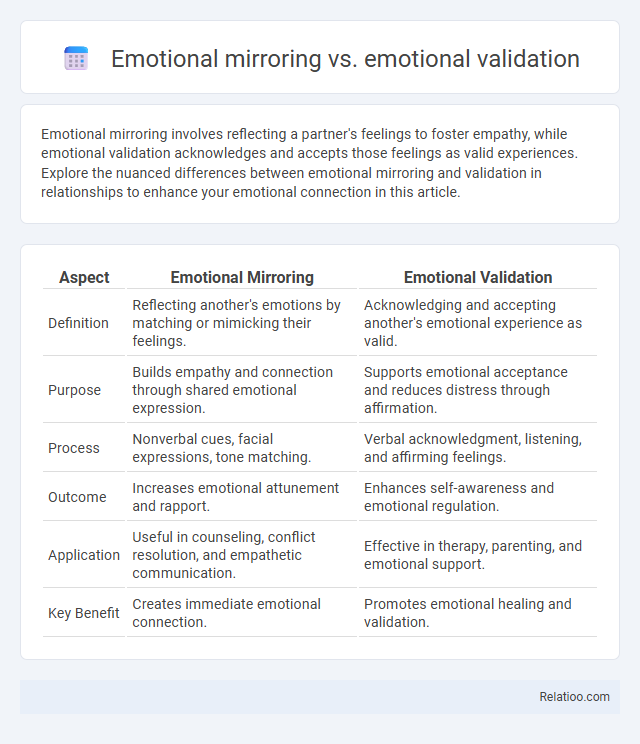Emotional mirroring involves reflecting a partner's feelings to foster empathy, while emotional validation acknowledges and accepts those feelings as valid experiences. Explore the nuanced differences between emotional mirroring and validation in relationships to enhance your emotional connection in this article.
Table of Comparison
| Aspect | Emotional Mirroring | Emotional Validation |
|---|---|---|
| Definition | Reflecting another's emotions by matching or mimicking their feelings. | Acknowledging and accepting another's emotional experience as valid. |
| Purpose | Builds empathy and connection through shared emotional expression. | Supports emotional acceptance and reduces distress through affirmation. |
| Process | Nonverbal cues, facial expressions, tone matching. | Verbal acknowledgment, listening, and affirming feelings. |
| Outcome | Increases emotional attunement and rapport. | Enhances self-awareness and emotional regulation. |
| Application | Useful in counseling, conflict resolution, and empathetic communication. | Effective in therapy, parenting, and emotional support. |
| Key Benefit | Creates immediate emotional connection. | Promotes emotional healing and validation. |
Understanding Emotional Mirroring
Emotional mirroring involves reflecting another person's feelings to help them recognize and process their emotions, fostering empathy and connection. Emotional validation goes beyond mirroring by affirming the legitimacy and importance of someone's emotional experience without judgment. Understanding emotional mirroring is crucial for building trust and rapport in relationships, as it enables individuals to feel seen and understood on a deeper emotional level.
Defining Emotional Validation
Emotional validation involves recognizing, accepting, and affirming another person's feelings without judgment, helping to build trust and emotional safety. Unlike emotional mirroring, which simply reflects the emotions someone expresses to show understanding, validation explicitly acknowledges the legitimacy of their experience. Your ability to practice emotional validation fosters deeper connections and supports emotional healing by making others feel truly seen and heard.
Key Differences Between Mirroring and Validation
Emotional mirroring involves reflecting your feelings back to you to show understanding, while emotional validation acknowledges and accepts your emotions as legitimate without necessarily repeating them. The key difference lies in mirroring emphasizing empathy through imitation of emotional expressions, whereas validation focuses on affirming your emotional experience to promote acceptance and comfort. Both techniques foster connection, but validation supports emotional resilience by honoring your personal feelings without judgment.
The Psychology Behind Emotional Responses
Emotional mirroring involves reflecting another person's feelings through facial expressions or body language, fostering empathy and emotional connection by signaling that emotions are recognized. Emotional validation goes deeper by verbally acknowledging and accepting someone's experience, which helps reduce emotional distress and builds trust in interpersonal relationships. Understanding these responses highlights how the brain processes social cues and regulates emotions, with mirror neurons playing a crucial role in empathy and emotional resonance.
Benefits of Emotional Mirroring
Emotional mirroring enhances empathy by reflecting another person's feelings, fostering deeper connection and trust in relationships. This process helps individuals feel understood and accepted, reducing emotional distress and promoting psychological well-being. Unlike emotional validation, which acknowledges feelings without reflecting them back, emotional mirroring actively demonstrates shared emotional experience, strengthening social bonds and communication.
Benefits of Emotional Validation
Emotional validation recognizes and affirms Your feelings, fostering trust and deeper emotional connections that promote mental well-being. Unlike emotional mirroring, which reflects emotions back to You, validation acknowledges the legitimacy of Your experience, reducing feelings of isolation and enhancing self-awareness. The benefits of emotional validation include improved communication, strengthened relationships, and increased emotional resilience.
Common Misconceptions
Emotional mirroring involves reflecting back someone's feelings to help them feel understood, while emotional validation goes further by affirming the legitimacy of those emotions without judgment. Common misconceptions confuse emotional mirroring with simply agreeing or offering solutions, neglecting the empathetic connection it fosters. Your ability to discern these differences enhances communication and strengthens emotional support in relationships.
When to Use Mirroring vs. Validation
Emotional mirroring involves reflecting another person's feelings by subtly mimicking their expressions and tone to create empathy and build connection, effective in early conversations to show understanding. Emotional validation explicitly acknowledges and accepts the other person's emotions without judgment, crucial during vulnerable moments to foster trust and reduce defensiveness. Use mirroring when aiming to establish rapport and emotional attunement, and choose validation when supporting someone through distress or seeking to affirm their emotional experience.
Practical Strategies for Everyday Conversations
Emotional mirroring involves reflecting your conversation partner's feelings by using empathetic language and body cues that show you understand their emotions, creating a sense of connection. Emotional validation goes further by acknowledging and accepting your partner's emotions as legitimate, helping to build trust and safety in your interactions. You can apply practical strategies like active listening, paraphrasing feelings, and maintaining open body language to effectively use both mirroring and validation in everyday conversations.
Enhancing Relationships Through Emotional Skills
Emotional mirroring involves reflecting your partner's feelings to show understanding, while emotional validation acknowledges and accepts those emotions as legitimate without judgment. Emotional mirroring strengthens empathy and connection by making your loved one feel seen and heard, whereas emotional validation builds trust by affirming their emotional experience. Mastering these skills enhances relationships by fostering deeper communication and emotional safety, allowing you to support your partner more effectively.

Infographic: Emotional mirroring vs Emotional validation
 relatioo.com
relatioo.com